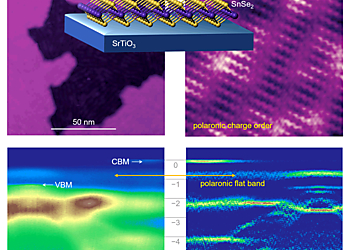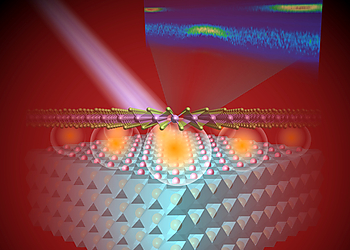Interfacial Polarons in van der Waals Heterojunction of Monolayer SnSe2 on SrTiO3 (001)
Result of the Month
Authors
Yahui Mao, Xiaochuan Ma, Daoxiong Wu, Chen Lin, Huan Shan, Xiaojun Wu, Jin Zhao, Aidi Zhao, and Bing Wang
Institutes
-
Yahui Mao – Hefei National Laboratory for Physical Sciences at the Microscale and Synergetic Innovation Center of Quantum Information and Quantum Physics, University of Science and Technology of China, Hefei, Anhui 230026, China
-
Xiaochuan Ma – Hefei National Laboratory for Physical Sciences at the Microscale and Synergetic Innovation Center of Quantum Information and Quantum Physics, University of Science and Technology of China, Hefei, Anhui 230026, China
-
Daoxiong Wu – CAS Key Laboratory of Materials for Energy Conservation, CAS Center for Excellence in Nanoscience, and Department of Material Science and Engineering, University of Science and Technology of China, Hefei, Anhui 230026, China
-
Chen Lin – Hefei National Laboratory for Physical Sciences at the Microscale and Synergetic Innovation Center of Quantum Information and Quantum Physics, University of Science and Technology of China, Hefei, Anhui 230026, China
-
Huan Shan – Hefei National Laboratory for Physical Sciences at the Microscale and Synergetic Innovation Center of Quantum Information and Quantum Physics, University of Science and Technology of China, Hefei, Anhui 230026, China
-
Xiaojun Wu – Hefei National Laboratory for Physical Sciences at the Microscale and Synergetic Innovation Center of Quantum Information and Quantum Physics, University of Science and Technology of China, Hefei, Anhui 230026, China; CAS Key Laboratory of Materials for Energy Conservation, CAS Center for Excellence in Nanoscience, and Department of Material Science and Engineering, University of Science and Technology of China, Hefei, Anhui 230026, China
-
Jin Zhao – Hefei National Laboratory for Physical Sciences at the Microscale and Synergetic Innovation Center of Quantum Information and Quantum Physics, University of Science and Technology of China, Hefei, Anhui 230026, China; ICQD and CAS Key Laboratory of Strongly-Coupled Quantum Matter Physics, and Department of Physics, University of Science and Technology of China, Hefei, Anhui 230026, China
-
Aidi Zhao – School of Physical Science and Technology, ShanghaiTech University, Shanghai 201210, China; Hefei National Laboratory for Physical Sciences at the Microscale and Synergetic Innovation Center of Quantum Information and Quantum Physics, University of Science and Technology of China, Hefei, Anhui 230026, China
Email: zhaoad@shanghaitech.edu.cn
-
Bing Wang – Hefei National Laboratory for Physical Sciences at the Microscale and Synergetic Innovation Center of Quantum Information and Quantum Physics, University of Science and Technology of China, Hefei, Anhui 230026, China
Email: bwang@ustc.edu.cn


